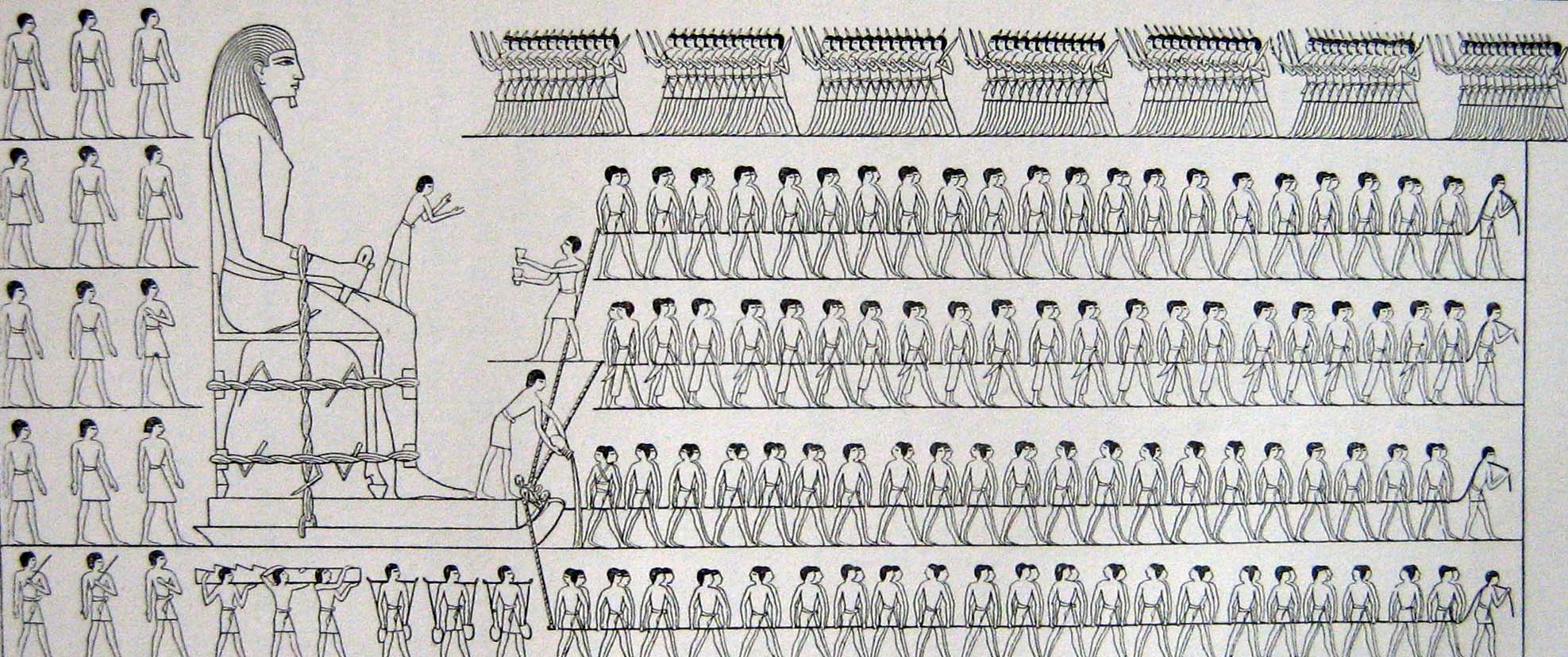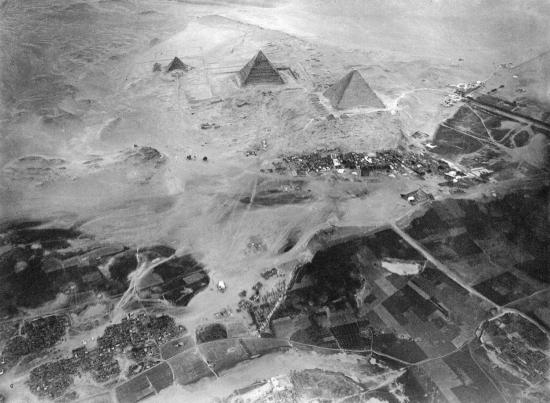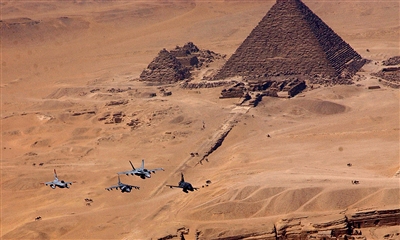11.2: The pyramids of Egypt
- Page ID
- 43043
History of Engineering: Building the Pyramids
One of the greatest feats of ancient engineering was the building of the great pyramids. While the pyramid structure is found in many cultures (Mesopotamia's ziggurats, Mesoamerica's pyramid, North America's pyramid-shaped mounds, China's flat-top pyramid, etc.), the great pyramids of Egypt captivate the imagination more than any other. The great pyramids of Egypt are over 145 meters tall dwarfing the Statue of Liberty in height and just a bit smaller than the Washington Monument which is 169 meters tall. Their base length is over 230 meters and they are estimated to have more than two million blocks of stone with the average weight of one of those stone being approximately 2.3 metric tons.
The pyramid structure seems to have originated from mastabas in Nubia. The stepped mastaba (Arabic for a type of bench) appeared around the Third Dynasty (2650-2575 BCE) in ancient Egypt and look very much like a true pyramid. These "pyramids" were surrounded by a number of other structures associated with the pyramids function. Sometime between the Third and Forth Dynasty a number of attempts were made to convert stepped mastabas into true pyramids. The conversion from a stepped mastaba to a true pyramid did have a number of failures, but the Egyptian engineers would work around the problems or in the case of complete failure note the problems and re-design avoiding the reason for failure. The great pyramids were built in the Forth and Fifth Dynasties using idle laborers1 during the flooding season. These pyramids are testament to the success of their engineering designs. Besides the great pyramids there are over 100 pyramids2 in Egypt and over 200 pyramids2 in the Sudan (Nubia). It is highly likely a team of engineers and specialized workers had to be employed full time working on the pyramid construction during these Dynasties.
Building a pyramid required a good grasp of mathematics, geometry, and knowledge of the qualities of the available materials. The design and positioning of the pyramids were very precise. The great pyramids are perfectly situated to have their sides line up to north, south, east, and west. The accuracy is uncanny for the time period. It is likely this was achieved by accurately observing the north star and using a plumb line. Other geometrical techniques were used to assure that the pyramid's edges would align at the apex.
 |
| Above is the Saqqara ostracon public domain of Wikipedia. A sketch of this ostracon is on page 52 (Figure 53) from Ancient Egyptian Construction and Architecture. It is were we see an architect's diagram using skilled mathematical techniques. The figure here shows what would amount to a numerical method of calculating curves (done by calculus now...unless you are using a computer, then you would do numerical methods again). This curve is an incomplete catenary, which suggests the Egyptians had knowledge of the usefulness of this shape (though it is not proof). However, the point to take here is the the Ancient Egyptians had significant mathematical knowledge especially from an engineering point of view. |
To build a pyramid the land had to be surveyed for a relatively flat area above the flood plain covering an area greater than the size of the proposed pyramid. Taking into consideration the enormous load to be placed on the proposed site, the bedrock had to be surveyed for defects to ensure a stable foundation. This is the type of job a civil engineer would do today.
After a site was designated it would be prepared by leveling off the rock foundation. Building would begin on this prepared site. In Egypt measurements were generally done using body parts. The standard unit of measure was the cubit which was a length from the elbow to the tip of the middle finger. For basic sort of work this measurement was sufficient, but for the great pyramids the royal cubit was used. This measured 52.5 cm and would normally be represented by a rod. The pyramid's base was design to be almost perfectly square using the rod as a measuring tool.
In building any structure to have level surfaces is extremely important. Egyptians developed levels using the force of gravity called a plumb level which is an application of the well-known plumb line. Plumb lines are still used today just as in ancient Egypt.
In the above figure from the Eternal Egypt web site ( go to the web site) you see the plumb level of Sennedjem. This level was used to ensure a level vertical surface. It is in essence no difference from the bubble levels we use today. While looking at the web site see if you can search for more tools that you might be vaguely familiar with (triangular level?, cubit?).
Most of the large stone blocks of the great pyramids where of low quality limestone, however the internal chambers and hallways used granite, and the pyramid was encased in a fine limestone. This encasement was polished to give the great pyramids a spectacular white appearance. The majority of the blocks to build the pyramid where quarried right next to the pyramids. Giza was chosen partly because of the good building materials in the area.
In the above figure (Figure 13, page 17) from Ancient Egyptian Construction and Architecture we see the clear evidence of blocks being removed from near the pyramid. This book is out of copyright.
Blocks were moved using sleds with water (or possibly oil) poured underneath. The blocks were taken up the pyramid using ramps of mud brick and rubble. While ancient Egyptians used ropes and levers there is no evidence of the use of pulleys. Even if they had knowledge of pulleys it is unclear if a block and tackle of sufficient strength could be made to move such large blocks. Ropes and levers were used to position in certain instances as well.
 |
| In the above sketch we see a heavy object (in this case a statue) being moved by a sled with a worker pouring water (or maybe oil but this seems less likely - why would they use water or oil? you answer this; debate) in the front of the sled. This sketch is based off a painting in the tomb of Djehutihotep on Wikipedia by John Gardner Wilkinson and is public domain "PD-US-expired" in the United States. A similar sketch is in Ancient Egyptian Construction and Architecture (figure 79, page 85) with some additional discussion. |
Mortar was used for settling the stones but not for cement as might be used today. The mortar, made of gypsum (plaster and sand), was very soft like butter. The advantages of gypsum mortar is that it is slow-setting and, while it is setting, it can act as a sort of lubricant to lessen the friction between large blocks. Gypsum mortar is still used for certain construction (in dry environments or internal structures) in modern times. Rockers were used for placement of the blocks while the gypsum mortar sets when careful placement was necessary.
As the building of the pyramid progressed ramps would be placed along side the edges of the pyramid to allow the workers using sleds to drag the large blocks up the ramps. New evidence suggests ramps might have been inside the pyramid as it was built as well. The outside ramps would be removed after their usefulness was at an end. After completion a limestone covering was placed on the pyramid as stated above. These coverings have all but dissolved today.
The building of the great pyramids of Egypt took an accumulation of knowledge, testing, and creative engineering. The Great Pyramid of Giza is one of the largest pyramids in the world and was the tallest structure in the world until the beginning of the renaissance in Europe many thousands of years after their construction. It along with the great pyramids of Mesoamerica are a testament to the ability of engineers to create grand structures and stretch our horizons. In modern times the Egyptian pyramids captivate the imagination of engineers and spur them to reach new heights as far as the moon and beyond.

The Giza pyramids from a Department of Defense photo. Note this is a combination picture showing an airplane (engineering history lesson 1) with pyramids (engineering history lesson 2)

Aerial photograph from 1904 of the pyramids of Giza taken on a balloon by Eduard Spelterini. Public Domain.

The Giza pyramids from a Department of Defense photo at a different angle.
To further investigations, I suggest the following books and websites:
- When the Pyramids were Built: Egyptian Art of the Old Kingdom, Dorothea Arnold, The Metropolitan Museum of Art, New York (1999)
- Egyptology: An Introduction to the History, Culture and Art of Ancient Egypt, James Putnam, Crescent Books, New York (1990)
- Ancient Egyptian Construction and Architecture, Somers Clarke and R. Engelback, Dover Publications, Inc., New York (1990). Original was published in 1930 and is out of copyright. This book has a lot of images that are not available anywhere else, it also has a number of facts that are now understood to be wrong, however from an engineering point of view it has a lot of still valid facts. Also while it says "architecture" in the title and "architect" in the book it is clear they are actually referring to engineers and engineering - a common misconception by laypeople.
- Eternal Egypt, Egyptian Center for Documentation of Cultural and Natural Heritage and IBM, http://www.externalegypt.org
- Dr. Zahi Hawass, One of the most famous modern Egyptologists, http://www.drhawass.com
- Dr. Kara Cooney, Young new Egyptologist who is very media savvy, http://www.karacooney.squarespace.com/
1Slaves were not used in building pyramids in Ancient Egypt. The story of slavery (for building the pyramids) in Egypt might have originated from ancient Greek writings that were inaccurate either by accident or by design. Herodotus ("the father of history") claimed that the pyramids were build by slaves, but he said he was told this and it was many many years after the construction of the pyramids. Some believe that the idea of slavery was "fake news" originated from ancient Greece, Egypt's enemy. However the origin of the story came about it has been clear for many years now that enslaved people were not used for the building of pyramids in Ancient Egypt.
2There is some debate on what a pyramid is and isn't so the exact number of pyramids is disputed, but all estimates are higher than the number sited here (hence the "over").

